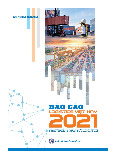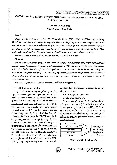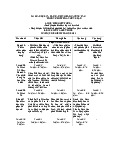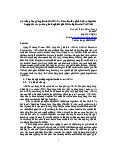



















Preview text:
MINISTRY OF EDUCATION & TRAINING HOA SEN UNIVERSITY
------------ FINAL REPORT CARGO AND INSURANCE
IN INTERNATIONAL TRANSPORT TOPIC:
CARGO IN INTERNATIONAL TRANSPORT BY
VARIOUS MEANS OF TRANSPORT Full Name :
1. Hồ Quỳnh Trâm – 2182026 2. Võ Minh Hy – 2183883
3. Đinh Thị Diệu Huyền – 2182018
4. Nguyễn Lê Hoàng – 2184172
5. Huỳnh Uyển Nhi – 2183268 Class : - 0100 NT327DE01 Semester : 2131 Instructor : Nguỵ Thị Sao Chi TP.HCM – 1, 2022
MEMBER PERFORMANCE EVALUATION MỨC ĐỘ HỌ VÀ TÊN MSSV
NỘI DUNG THỰC HIỆN HOÀN THÀNH
PART 1: chia outline, làm mục 6 Hồ Quỳnh Trâm 2182026 + mục 3d + làm ppt 100%
PART 2: làm câu 1, câu 2
PART 1: làm mục 1 + mục 2 + Võ Minh Hy 2183883 mục 3a 100% PART 2: làm câu 1
PART 1: làm mục 7 + mục 8 + Đinh Thị Diệu Huyền 2182018 mục 3c 100% PART 2: làm câu 1
PART 1: làm mục 3 + mục 4 + Nguyễn Lê Hoàng 2184172 mục 3b 100% PART 2: làm câu 1
PART 1: làm Acknowledgement
+ Abstract + Introduction + mục 5 Huỳnh Uyển Nhi 2183268 + Conclusion + chia outline + 100% tổng hợp word
PART 2: làm câu 1, câu 2 LECTURER’S FEEDBACK
...................................................................................................................................
...................................................................................................................................
...................................................................................................................................
...................................................................................................................................
...................................................................................................................................
...................................................................................................................................
...................................................................................................................................
...................................................................................................................................
...................................................................................................................................
...................................................................................................................................
...................................................................................................................................
...................................................................................................................................
...................................................................................................................................
...................................................................................................................................
...................................................................................................................................
...................................................................................................................................
...................................................................................................................................
...................................................................................................................................
...................................................................................................................................
................................................................................................................................... TABLE OF CONTENTS
TABLE OF FIGURE...........................................................................................iii
ACKNOWLEDGEMENT...................................................................................iv
ABSTRACTS.......................................................................................................v 1.
What are dangerous goods?...........................................................................1 2.
Dangerous goods classification?...................................................................1
2.1. Class 1: Explosive Substances or Articles………………….…………...1
2.2. Class 2: Gases (Gases)…………………………………….………..…...2
2.3. Class 3: Flammable Liquids………………………………...….……….3
2.4. Class 4: Dangerous Solid…………………………………….………….4
2.5. Class 6: Toxic Substances or Infectious substances……………………..4
2.6. Class 7: Radioactive Materials………………………………………….5
2.7. Class 8: Corrosive Substances…..………………………………………5 3.
Transport of dangerous cargo: How is it regulated?.......................................6
3.1. On the basis of transport modes…………………………………………8
3.1.1. Sea – IMDG Code and others...........................................................8
3.1.2. Air – DGR and ICAO Technical Instructions...................................8
3.1.2.3. Icao Technical Instructions..........................................................14
3.1.3. Road – Motor Vehicles Rules and Hazardous Substances Rules....14
3.1.4. Barge - ADN and others.................................................................15 4.
Storing and handing dangerous goods.........................................................19
4.1. Handing Dangerous goods………………………..…………………...19
4.1.1. Know the cargo groups...................................................................20 i
4.1.2. Know the classification of dangerous cargo...................................20
4.2. IMDG cargo is usually classified into………………………………….20
4.2.1. Dangerous Goods Classes..............................................................20
4.2.2. Check the table...............................................................................21
4.2.3. Check the cargo document..............................................................21
4.2.4. Check the cargo for correct packaging...........................................21
4.2.5. Check when handing cargo.............................................................21
4.2.6. Inspect when handing explosive cargo...........................................22
4.2.7. Know the Emergency Procedure....................................................22
4.2.8. Storing dangerous goods................................................................22 5.1.
Introduction……………………………………………………………..23
5.2. Selection Of The Mode Of Transport For The Carriage Of Dangerous
Goods……………………..………………………………………………………..24
5.3. Risk management in transportation of dangerous goods by road…….....25 6.
Packaging, labelling, documentation, segregation, training requirements...27
6.1. Packaging……………………………………….………………………27
6.2. Labelling…………………………………..……………………………27
6.3. Segregation……………………………..………………………………28
6.4. Training requirements………………………….………...…………….28 7.
Documentation requirements......................................................................28 8.
High Consequece........................................................................................30
CONCLUSION...................................................................................................33 ii
REFERENCES....................................................................................................34
PART 2................................................................................................................36 iii TABLE OF FIGURE
Figure 1: Hazardous Materials Classes & Commonly Transported Example Materials.1
Figure 2: Explosive Substances or Articles....................................................................2
Figure 3: Flammable Gases...........................................................................................2
Figure 4: Non-flammable, non-toxic gases....................................................................3
Figure 5: Toxic Gases....................................................................................................3
Figure 6: Flammable liquids..........................................................................................3
Figure 7: Substances liable to spontaneous Combustion................................................4
Figure 8: Substances which, in contact with water, emit flammable gases....................4
Figure 9:Toxic Substances or Infectious........................................................................5
Figure 10: Radioactive Materials...................................................................................5
Figure 11: Corrosive Substances....................................................................................5
Figure 12: Miscellenious Dangerous Substances and Article.........................................6
Figure 13: Flammable liquids (Alternative sign)...........................................................6
Figure 14: Explosives division 1.4, 1.5, 1.6...................................................................9
Figure 15: Flammable gases........................................................................................10
Figure 16: Non-flammable non-toxic gases (Alternative sign)....................................10
Figure 17: Toxic gases.................................................................................................10
Figure 18: Flammable liquids (Alternative sign).........................................................10
Figure 19: Flammable soilds, self-reactive substances and soild desentized explosives
.....................................................................................................................................11
Figure 20: Substances liable to spontaneous combustion.............................................11
Figure 21: Substances which in contact with water emit flammable gases..................11
Figure 22: Oxidizing substances..................................................................................12
Figure 23: Oxidizing peroxides (Alternative sign).......................................................12
Figure 24: Toxic Substances or Infectious...................................................................13
Figure 25: Radioactive Materials.................................................................................13
Figure 26: Corrosive substances..................................................................................13
Figure 27: Common Examples (Dry ice, First aid kits, Vehicles)................................14
Figure 28: Procedure for risk management..................................................................26 iv ACKNOWLEDGEMENT
Dear Lecturer of Cargo and Insurance in international transport Nguy Thi Sao
Chi and all my friends in group 4.
To start with, I would like to express my profound gratitude to Lecturer of Cargo
and Insurance in international transport Nguy Thi Sao Chi for thorough guidance
during the project development. Moreover, I also would like to express my sincere
thanks to my friends in Hoa Sen University for their dedication in conveying
knowledge throughout the time I have studied. The knowledge gained in the process, I
experienced, was not only a strong foundation for the thesis research but also a
valuable package for me to enjoy life in a firm and confident manner. Finally, group 4
wish the best will come to all of you. v ABSTRACTS
Reason for writing: The purpose of this study is to increase the understanding of
multiple stakeholders’ needs, benefits and challenges, Find out the purpose of the
Transportation of Dangerous Goods (TDG) Act and Regulations is to promote public
safety when dangerous goods are being handled, offered for transport or transported by
road, rail, air, or water (marine). TDG also establishes safety requirements.
Problems: Continuously growing needs of society brings with it the development
of industry, new technologies and use of new types of hazardous substances. Each
transport of hazardous substance entails some risk of incident. This article deals with
problems of transporting of dangerous goods by rail. The paper describes the
Directive, which forms the basis of the transport of dangerous goods.
Practical implications: The outcome of this study can serve as input into the
development of solutions and associated incentive models to improve the
management of transportation of dangerous goods.
Design/methodology/approach: This chapter presents methods and tools to help
policy-makers and the private sector to assess the vulnerability of areas under their
control, with a specifi c focus on toxic releases and explosions. These methods and
tools provide models and data for the implementation of a Spatial Decision Support System (SDSS). Outline of project: The paper includes 8 parts: 1. What are dangerous goods?
2. Dangerous good classification
3. Transport of dangerous cargo: How is it regulated? 4. Storing and handling 5. Risk management 6. Packaging 7. Documentation requirements 8. High consequences vi
1. WHAT ARE DANGEROUS GOODS?
Dangerous goods are goods that, in the process of storage, preservation,
transportation, loading, unloading, and delivery, arise dangerous incidents such as
explosions, toxic effects, destruction of means of transport, release of Radiation affects
the environment and human life. When transporting Marine, dangerous goods cause
damage to equipment, vehicles and loss of center of gravity, capsize or sink ships.
In addition, according to the Road Traffic Law defines: “Dangerous goods are
goods containing dangerous substances that, when transported on the road, are capable
of causing danger to life, human health, the environment, safety and National security."
Based on the above concepts, goods are considered dangerous goods when;
Contains toxic substances, affecting human health and life.
Causing danger to marine vehicles during transportation.
Causing environmental pollution, disrupting national security order.
2. DANGEROUS GOODS CLASSIFICATION?
Figure 1: Hazardous Materials Classes & Commonly Transported Example Materials
2.1. Class 1: Explosive Substances or Articles
Explosives are divided into the following dangerous groups:
+ Group 1.1: Including substances and items where the risk of mass explosion is potential 1
+ Group 1.2: Includes substances and items that create a hazard but are not a mass explosion hazard.
+ Group 1.3: Including substances and articles with potential for slight fire or
explosion hazard, not a mass explosion hazard.
Group 1.4: Including substances and articles that do not present a serious hazard.
+ Group 1.5: Includes substances that are very insensitive but have a mass explosion hazard
+ Group 1.6: Includes items that are extremely insensitive and do not have a mass explosion hazard
Figure 2: Explosive Substances or Articles
2.2. Class 2: Gases (Gases)
Gases are substances that have the following properties:
+ At a temperature of 50oC, the evaporating pressure is more than 300kPa
+ Completely gaseous at 20oC at standard pressure 101.3kPa
The above-mentioned gas is carried on board in the following forms: compressed
gas, liquefied gas, liquefied gas under high pressure, liquefied gas under low pressure and gas dissolved in solution.
These gases can be divided into three basic categories: + Flammable Gases 2
Figure 3: Flammable Gases
+ Non-flammable, non-toxic gases (Non-Flammable, Non-Toxic Gases)
Figure 4: Non-flammable, non-toxic gases + Toxic Gases Figure 5: Toxic Gases
2.3. Class 3: Flammable Liquids
Flammable liquids can be classified into two main categories:
Flammable Liquids: These are liquids transported at a temperature equal to or
greater than their flash point or compounds that are transported under high temperature
in liquid form and which give off flammable gases at equivalent or lower than the maximum transport temperature.
Liquids that have had their explosive properties suppressed: these are essentially
explosive compounds but have been dissolved or mixed with water or other liquids,
creating a homogeneous liquid mixture to suppress the density explosiveness. 3
Figure 6: Flammable liquids
2.4. Class 4: Dangerous Solid
Hazardous solids are substances other than explosive-type compounds. Under
transport conditions, these substances are always flammable or they contribute to a fire.
Hazardous solids can be divided into the following main categories: + Group 4.1: Flammable Solids
+ Group 4.2: Substances liable to spontaneous Combustion
Figure 7: Substances liable to spontaneous Combustion
Group 4.3: Solids that, when in contact with water, can produce flammable gases
(Substances which, in contact with water, emit flammable gases)
Figure 8: Substances which, in contact with water, emit flammable gases
Class 5: Oxidizing Substances and Organic Peroxides + Group 5.1: Flammable oxides
+ Group 5.2: Flammable organic peroxides
2.5. Class 6: Toxic Substances or Infectious substances 4
Toxic substances are substances that can cause death or serious injury or serious
harm to human health if inhaled or exposed to them.
Infectious substances are substances that themselves contain pathogens, so it is
possible to infect animals or humans.
Figure 9:Toxic Substances or Infectious
2.6. Class 7: Radioactive Materials
Radioactive substances are understood to be any radioactive material for which
either the enriched radioactivity or the absolute radioactivity shown in the
consignment declaration exceeds the assigned value.
Figure 10: Radioactive Materials
2.7. Class 8: Corrosive Substances
These are substances that have the ability to damage or even destroy other
materials, goods or vehicles if there is a leak or exposure due to chemical reactions. 5
Figure 11: Corrosive Substances
Category 9: Miscellenious Dangerous Substances and Articles
These are substances and articles that are different from the substances and
articles classified in the above 8 dangerous goods but have dangerous properties.
Figure 12: Miscellenious Dangerous Substances and Article
3. TRANSPORT OF DANGEROUS CARGO: HOW IS IT REGULATED?
Dangerous goods or hazardous goods (also abbreviated as HAZMAT) are
materials in solid, liquid or gas form, which have the potential to cause harm to people,
animals, the environment and their means of transport, if they are handled inadequately.
Dangerous goods (Hazmat) have specific regulations when it comes to their
transportation, may that be via road, sea or air. It is essential to eliminate the risks
associated with dangerous materials as much as possible, hence we need to apply
safety precautions. There are several national laws in effect in most countries, plus
hazmat cargo falls under regulations by international treaties as well, for their safe
transport, usage, storage and disposal. 6
Figure 13: Flammable liquids (Alternative sign)
The UN Recommendations on the Transport of Dangerous Goods, issued by the
United Nations Economic and Social Council, serves as the groundwork for most
regulations on a regional, national and international level. The International Civil
Aviation Organization (ICAO) has incorporated the UN Model into its own set of
internationally agreed dangerous goods regulations for air transport of hazardous
materials, the so-called ICAO Technical Instructions, with some alterations for the
specific features of air transportation.
The International Air Transport Association (IATA) provides global standards for
documentation and safe handling of dangerous goods in air transport, as well as special hazmat training.
IATA has a strong cooperation with local governments and ICAO in the
development of provisions in order to ensure effective rules and guidelines on
dangerous goods transportation by air. All IATA regulations are in accordance with the ICAO technical instructions.
IATA’s globally used Dangerous Goods Regulations (DGR) manual is the basis
and standard for shipping hazardous goods by air, recognized by airlines.
When it comes to maritime transportation, the International Maritime
Organization (IMO) is the normative authority for safety, security and environmental
performance of international shipping. It serves as a regulatory entity in sea transport,
and produces the International Maritime Dangerous Goods Code, also known as the
IMDG Code, part of the International Convention for the Safety of Life at Sea (SOLAS). 7
The International Maritime Dangerous Goods (IMDG) Code was developed to
internationally standardize the transport of dangerous goods. Moreover, this code also
prevents the risk of cargo accidents, since it contains a number of conditions set for
stowage, packaging, labeling and documentation of the entire shipping process till the
cargo reaches the consignee, as well as courses of action in case of accidents or emergency.
When it comes to dangerous goods, there are strict rules for each stage of the
shipping process – handling, packaging, labelling, marking, stowage, segregation,
transport and emergency response. These exist in the form of international agreements,
which are closely aligned with the UN recommendations and, while not mandatory, are
universally accepted. Additionally, there are national regulations. The rules governing
the movement of dangerous goods differ across transport modes.
3.1. On the basis of transport modes
3.1.1. Sea – IMDG Code and others
The International Maritime Dangerous Goods (IMDG) Code is, by its own
definition, “the standard guide to all aspects of handling dangerous goods and marine
pollutants in sea transport”. Its key objectives are to: a) protect human life. b) prevent marine pollution.
c) facilitate free movement of dangerous goods.
Developed by the International Maritime Organisation (IMO), it applies to all
cargo-carrying ships and is amended every two years. It reportedly covers 3,500
dangerous goods transported in packaged form.
However, there are many more dangerous goods shipped in bulk in solid, liquid
and gaseous form. The International Maritime Solid Bulk Cargoes (IMSBC) Code has
provisions on the carriage of solid bulk cargo, with the exception of grain.
3.1.2. Air – DGR and ICAO Technical Instructions
The International Air Transport Association (IATA) calls the Dangerous Goods
Regulations (DGR) “the global reference for shipping dangerous goods by air and the
only standard recognised by airlines”. It details shipper/operator responsibilities, 8
transport and storage quantities, and forbidden goods. It also has provision on training,
security and incident reporting.
A second set of regulations, the ICAO, seeks to ensure airlines carry dangerous
goods without the cargo posing a danger to the aircraft or its occupants. 3.1.2.1. Air - DGR
Dangerous goods are goods that contain dangerous substances during
transportation. This type of goods has the potential to cause great harm to human life,
the environment, more dangerous than national security.
From the above concept, we can realize dangerous goods for aviation when:
Such goods contain toxic substances that greatly affect human health and life.
Such goods cause serious pollution to the environment, causing unsafety to the country.
Such goods contain substances that are dangerous to air transport during transportation 3.1.2.2.
IATA Dangerous Goods Groups for Air Transport
Class 1: Explosives (EXplosives)
Based on the level of danger or the explosive power of the explosive, people will
be divided into 6 subgroups as follows: Division 1.1, Division 1.2, Division 1.3,
Division 1.4, Division 1.5 and Division 1.6. Can take the example of grouping such as
when an explosion in a house can cause a collapse, or just an explosion sounds like a firecracker...
And in those 6 subgroups, they continue to be divided into smaller groups
according to the alphabet A, B, C, D... For example, taste 1.1A, 1.3B, 1.4S...Most of
the substances These explosives are prohibited from being transported on passenger
aircraft as well as cargo aircraft. Only the ammunition for infantry guns with code 1.4S
is accepted by some airlines to be carried on passenger planes, the rest must use cargo machines. 9
Figure 14: Explosives division 1.4, 1.5, 1.6 Class 2: Gases (Gases)
Divided into 3 groups including:
+ Gas lighters, gas cylinders... are collectively known as Division 2.1.
Figure 15: Flammable gases
+ Easy breathing oxygen tank called Division 2.2
Figure 16: Non-flammable non-toxic gases (Alternative sign)
+ The toxic gas is called Division 2. 10 Figure 17: Toxic gases
Class 3: Flammable Liquid
Includes paint, oil, gasoline, alcohol, high alcohol alcohol
Figure 18: Flammable liquids (Alternative sign) 11




